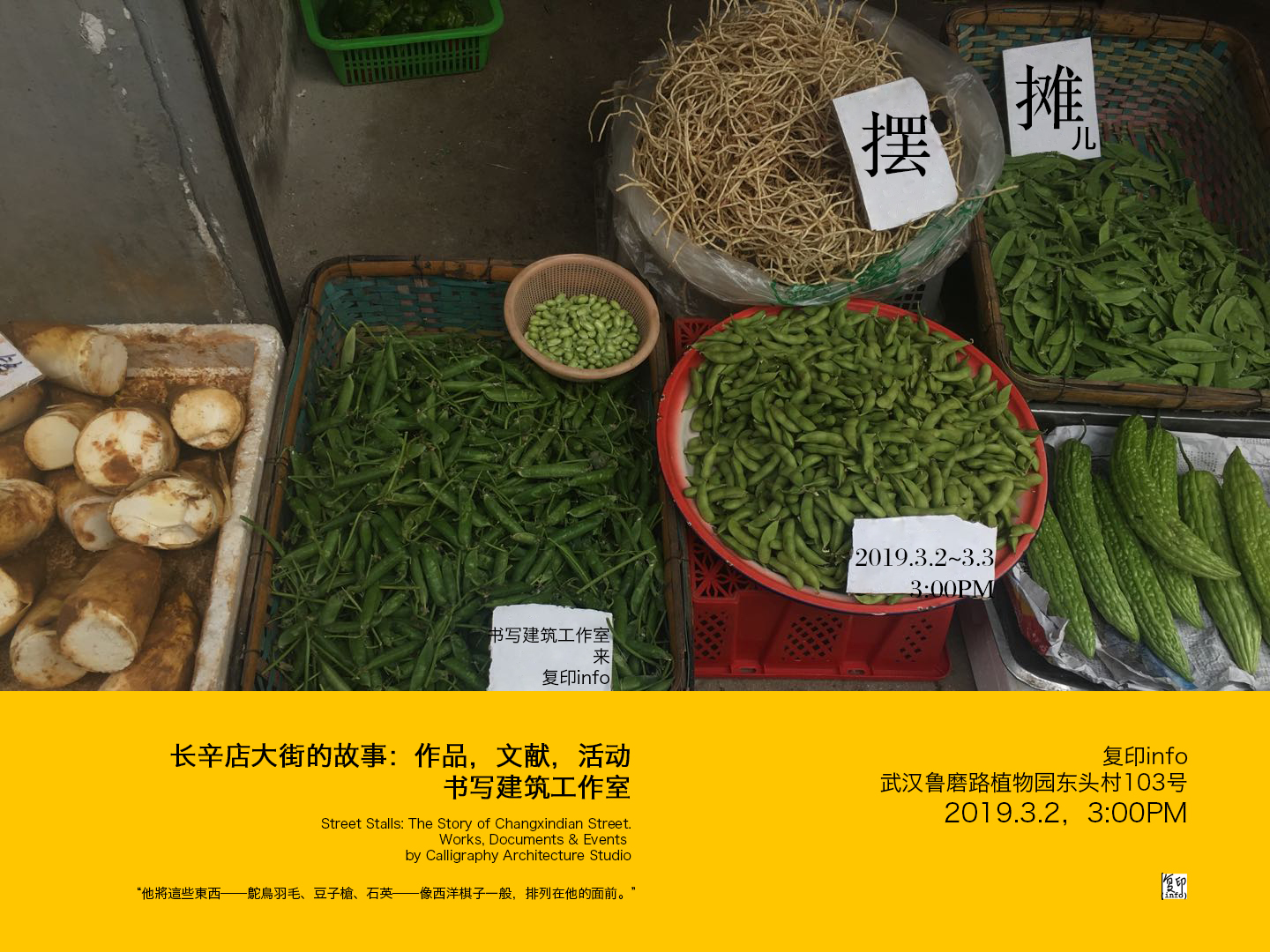摆摊儿 | 长辛店大街的故事:作品,文献,活动
书写建筑工作室
2019.3.2(Sat),3:00PM
Street Stalls: The Story of Changxindian Street. Works, Documents & Events
by Calligraphy Architecture Studio
书写建筑工作室3月2日的周末下午三点会在复印info进行项目展示,
事关乎位于京汉铁路的另一头节点北京长辛店的城市化发生,并有一场讨论。
讨论关键词:城市化,工业化,京汉铁路,卢沟桥,加速,在地工作,空间研究 ……
复印info地址:武汉植物园路东头村103号。在大东头,即没到植物园正门右边口子进村,走过两边是田的水泥路上坡后,
到达一个小卖部/麻将室之后(门口是喜羊羊和小黄鸭的摇摇车),右拐进巷子走100米看到有涂鸦的啤酒仓库边上就到。
复印联系:fuyininfo@disroot.org
擺攤兒 | 長辛店大街的故事:作品,文獻,活動
書寫建築工作室
馬可波羅對他曾經到訪的城市的描述,有這樣的長處:你可以在思想中遊逛這些城市,沉迷其中,停步享受涼爽的空氣,或者逕自跑開。
他將這些東西——鴕鳥羽毛、豆子槍、石英——像西洋棋子一般,排列在他的面前。
———卡爾維諾《看不見的城市》
本次活動將引領大家前往長辛店,北京近郊一處擁有城市地形和悠久歷史的小鎮。2015年,書寫建築工作室啟動“長辛店記”藝術計劃,設置“城市展”在地工作站,至今已完成四個階段,包括北京、南京、臺北、臺南等地的數次展覽。長辛店位於北京的西五環之外,曾經以五里長的長辛店大街和造火車的二七機車廠聞名。2017年,伴隨著“棚戶區改造”項目的實施,90% 的居民搬離了世代居住的街巷,加之機車工廠的停產,長辛店正在經歷的巨變,提供了一個時間軸線上的原點。我們將如何理解城市的過去,又將如何想像城市的未來呢,借助於文字、影像、圖紙、裝置作品?書寫建築工作室將以講故事的方式,給出自己的思考,試圖理解歷史上的城市發展過程,如何呈現出一種身份認同和一種幾近消失的生活方式。
Street Stalls: The Story of Changxindian Street
Works, Documents & Events
by Calligraphy Architecture Studio
The descriptions of cites Marco Polo visited had this virtue: you could wander through them in thought, become lost, stop and enjoy the cool air, or run off.He arranged objects - ostrich plumes, pea-shooters, quartzes - in front of him like chessmen.
Italo Calvino Invisible Cities
Welcome to Changxindian, a small town in the suburbs of Beijing rich in urban topography and historical significance. In 2015, Calligraphy Architecture Studio launched the Chang Xin Dian Project and set up a local workstation of the City-exhibit. So far, four stages had been completed, including exhibitions in Beijing, Nanjing, Taipei, Tainan. Changxindian was located outside the west fifth ring road in Beijing, once well-known for its Wu Li Chang (2.5 km) Changxindian Street and Er-Qi (7th February) Locomotive & Rolling Stock Works. In 2017, 90% of the residents who had been living there for generations had left since the implementation of the “Shanty Town Renovation Project”. The suspension of the locomotive works, and other similar closing act would be repeated on Changxindian. Would we be able to understand the city’s past and imagine her future through texts, images, drawings and installations? Calligraphy Architecture Studio will give us some inspiration by stories to seek to understand how the classical urban plan represents both an identity and a way of life that is nearing eradication.
書寫建築工作室
書寫建築致力於思考與探索介於理論思辨與建造技藝之間的,
帶有書寫意涵的城市設計與當代藝術的可能性。主要展覽包括:
2019年,北京五金“擺攤兒:長辛店大街的故事”移動個展;
2017年,南京藝術學院美術館“社會速寫”展覽;
2016年,臺北當代藝術中心“肖像擺”展覽;
2015年,北京Tabula Rasa畫廊“長辛店記 II”個展,北京單向空間“六環比五環多一環”展覽,臺南齁空間“家國之外:原鄉中的異鄉人”展覽;
2014年,北京箭廠空間“勾踐 · 考”合作個展;
2013年,維也納MAK“東方的承諾:東亞的當代建築與空間實踐”展覽;
2011年,臺北UCG“朗讀違章:王澍 × 謝英俊建築展”等。
Calligraphy Architecture Studio, or CA Studio, studies the connection between theoretical speculation and architectural techniques, and explores the new horizon of urban design and related art with “Calligraphy” implications. Past exhibitions include:
Street Stalls: The Story of Changxindian Street, Wu Jin, Beijing, 2019
Sketching from Society, Art Museum of Nanjing University of the Arts, Nanjing, 2017
Portrait Portrait, Contemporary Art Center, Taipei, 2016
Chang Xin Dian Project II, Tabula Rasa Gallery, Beijing, 2015
Between the 5th & 6th Ring Road in Beijing, OWSpace, Beijing, 2015
Beyond the Borderline: Exiles from the Native Land, Howl Space, Tainan, 2015
Go Jian Quest, Arrow Factory, Beijing, 2014
Eastern Promises: Contemporary Architecture and Spatial Practices in East Asian, MAK, Vienna, 2013
Illegal Architecture: Wang Shu & Hsieh Ying-Chun, UCG, Taipei, 2011
